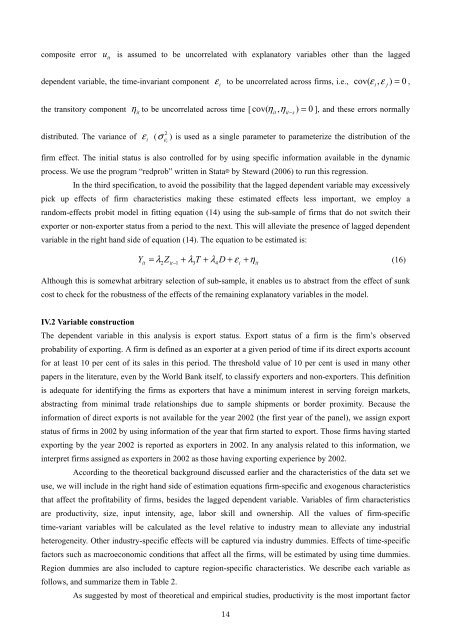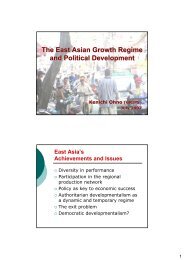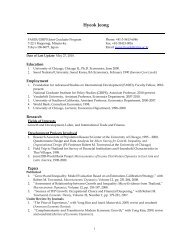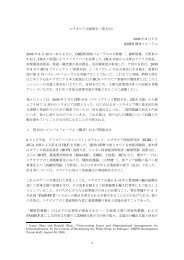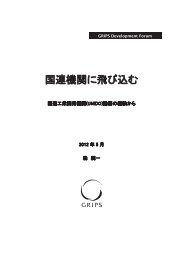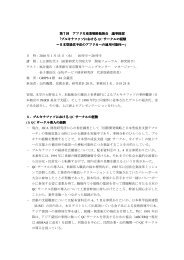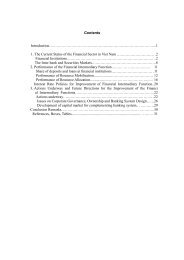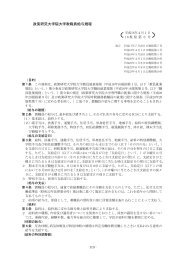Evidence from Firm-level Data in Vietnam
Evidence from Firm-level Data in Vietnam
Evidence from Firm-level Data in Vietnam
You also want an ePaper? Increase the reach of your titles
YUMPU automatically turns print PDFs into web optimized ePapers that Google loves.
composite error u itis assumed to be uncorrelated with explanatory variables other than the laggeddependent variable, the time-<strong>in</strong>variant componentε to be uncorrelated across firms, i.e., cov( ε , ) = 0 ,iiε jthe transitory componentη to be uncorrelated across time [ cov( η , ) = 0 ], and these errors normallyititη it−sdistributed. The variance ofε ( σ ) is used as a s<strong>in</strong>gle parameter to parameterize the distribution of thei2ε ifirm effect. The <strong>in</strong>itial status is also controlled for by us<strong>in</strong>g specific <strong>in</strong>formation available <strong>in</strong> the dynamicprocess. We use the program “redprob” written <strong>in</strong> Stata® by Steward (2006) to run this regression.In the third specification, to avoid the possibility that the lagged dependent variable may excessivelypick up effects of firm characteristics mak<strong>in</strong>g these estimated effects less important, we employ arandom-effects probit model <strong>in</strong> fitt<strong>in</strong>g equation (14) us<strong>in</strong>g the sub-sample of firms that do not switch theirexporter or non-exporter status <strong>from</strong> a period to the next. This will alleviate the presence of lagged dependentvariable <strong>in</strong> the right hand side of equation (14). The equation to be estimated is:Yit= λ2Zit− 1+ λ3T+ λ4D+ εi+ ηit(16)Although this is somewhat arbitrary selection of sub-sample, it enables us to abstract <strong>from</strong> the effect of sunkcost to check for the robustness of the effects of the rema<strong>in</strong><strong>in</strong>g explanatory variables <strong>in</strong> the model.IV.2 Variable constructionThe dependent variable <strong>in</strong> this analysis is export status. Export status of a firm is the firm’s observedprobability of export<strong>in</strong>g. A firm is def<strong>in</strong>ed as an exporter at a given period of time if its direct exports accountfor at least 10 per cent of its sales <strong>in</strong> this period. The threshold value of 10 per cent is used <strong>in</strong> many otherpapers <strong>in</strong> the literature, even by the World Bank itself, to classify exporters and non-exporters. This def<strong>in</strong>itionis adequate for identify<strong>in</strong>g the firms as exporters that have a m<strong>in</strong>imum <strong>in</strong>terest <strong>in</strong> serv<strong>in</strong>g foreign markets,abstract<strong>in</strong>g <strong>from</strong> m<strong>in</strong>imal trade relationships due to sample shipments or border proximity. Because the<strong>in</strong>formation of direct exports is not available for the year 2002 (the first year of the panel), we assign exportstatus of firms <strong>in</strong> 2002 by us<strong>in</strong>g <strong>in</strong>formation of the year that firm started to export. Those firms hav<strong>in</strong>g startedexport<strong>in</strong>g by the year 2002 is reported as exporters <strong>in</strong> 2002. In any analysis related to this <strong>in</strong>formation, we<strong>in</strong>terpret firms assigned as exporters <strong>in</strong> 2002 as those hav<strong>in</strong>g export<strong>in</strong>g experience by 2002.Accord<strong>in</strong>g to the theoretical background discussed earlier and the characteristics of the data set weuse, we will <strong>in</strong>clude <strong>in</strong> the right hand side of estimation equations firm-specific and exogenous characteristicsthat affect the profitability of firms, besides the lagged dependent variable. Variables of firm characteristicsare productivity, size, <strong>in</strong>put <strong>in</strong>tensity, age, labor skill and ownership. All the values of firm-specifictime-variant variables will be calculated as the <strong>level</strong> relative to <strong>in</strong>dustry mean to alleviate any <strong>in</strong>dustrialheterogeneity. Other <strong>in</strong>dustry-specific effects will be captured via <strong>in</strong>dustry dummies. Effects of time-specificfactors such as macroeconomic conditions that affect all the firms, will be estimated by us<strong>in</strong>g time dummies.Region dummies are also <strong>in</strong>cluded to capture region-specific characteristics. We describe each variable asfollows, and summarize them <strong>in</strong> Table 2.As suggested by most of theoretical and empirical studies, productivity is the most important factor14


